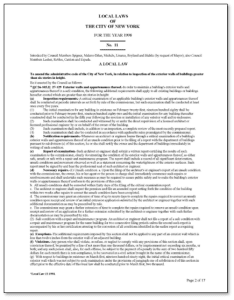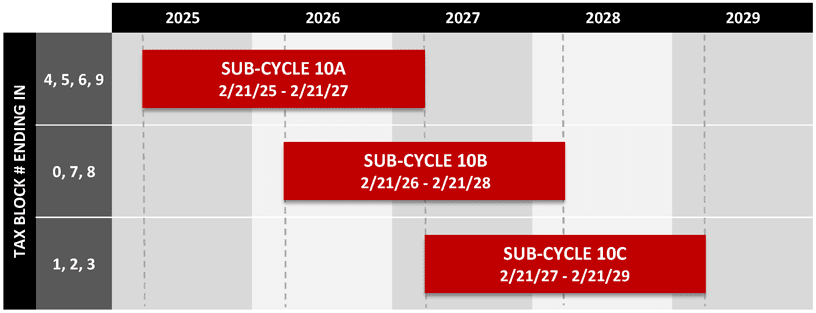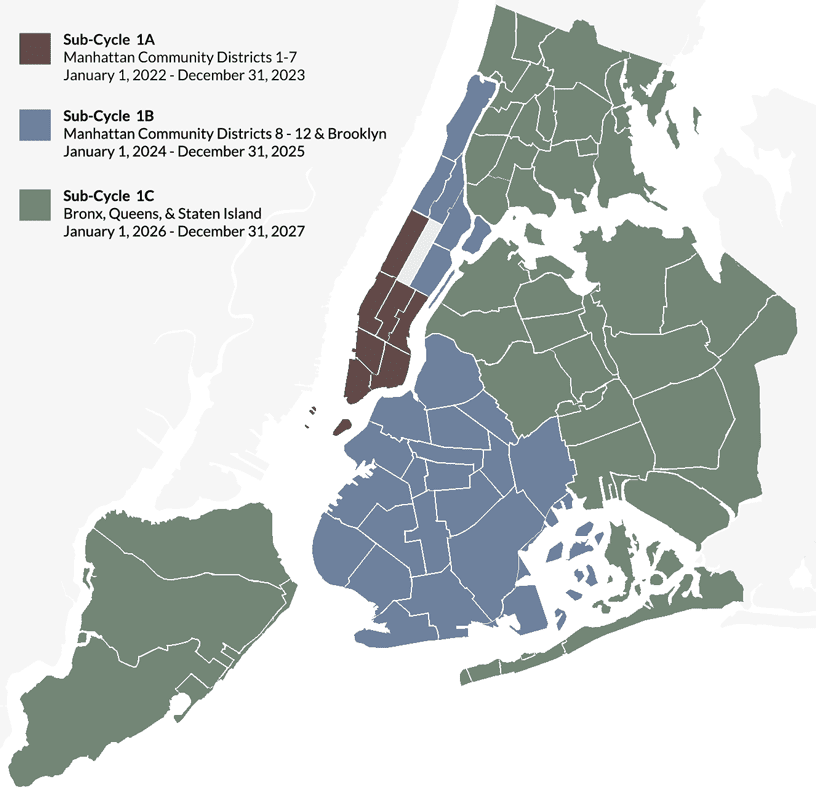Facades: Local Law 11 of 1998 (FISP)

Facades of NYC buildings taller than six stories must be inspected every five years, and the results of this critical examination filed with the Department of Buildings (DOB). The critical examination must be performed by a Qualified Exterior Wall Inspector (QEWI): a registered architect or professional engineer with a minimum of seven years’ facade inspection experience.
In 1979, a piece of terra cotta fell from a Manhattan building, striking and killing a passing student, leading to the City Council’s immediate passing of statute Local Law 10 of 1980 (LL10).
Local Law 11 of 1998 (LL11) amplified the requirements of Local Law 10. It comprises a section of the NYC Administrative Code (1 RCNY 103-04) fleshed out in rules promulgated by the DOB. The Local Laws and rules safeguarding the condition of facades are now known as the Facade Inspection & Safety Program (FISP).

Superstructures maintains a website with a wealth of information on Local Law 11: LocalLaw11.com
More on Local Law 11 / FISP
The critical examination of the building’s exterior walls by a QEWI entails a comprehensive examination of the facade and railings, and detailed reporting requirements with a description of observations and photographic evidence of inspections.


Requirements include a complete visual examination, and physical inspection performed at intervals of not more than 60 feet on all walls facing a public right of way. Cavity walls require, at minimum, an exploratory probe at the location of each physical inspection, to determine the presence, condition, and spacing of wall ties connecting the veneer to its backup.
Conditions are classified as:
SAFE conditions are those not requiring repair or maintenance to sustain the structural integrity of the building exterior and will not become UNSAFE during the next five years.
UNSAFE conditions must be corrected on an expedited basis (within 90 days). Building owners must immediately commence repairs or reinforcement. A QEWI who becomes aware of a physically UNSAFE condition during an inspection must immediately notify the DOB and the building owner and recommend the type and location of public protection (sidewalk shed or other measures).
SWARMP conditions must be repaired prior to the next inspection cycle. A recommended repair date must be included in the critical examination report. The QEWI must report corrections of conditions reported as SWARMP in the prior cycle as UNSAFE if they have not been addressed at the time of the current cycle.
The Critical Examination report must be filed with the DOB and must contain all DOB-required information to be deemed “acceptable.” The report must be filed within 60 days of completion of the final inspection, and not more than one year after the completion of the physical examination.
FISP inspections occur in three “staggered” two-year “sub-cycles,” commencing one year apart. Buildings are divided into three groups, (Sub-cycles A, B and C), based on the last digit of their respective “Block” number (as in “Block and Lot”).
The next five-year cycle (Cycle 10) will commence on February 21, 2025 and will run through February 20, 2030.
This table shows the three phased sub-cycles within Cycle 10:

Conditions of Parapets
Beginning on January 1, 2024, all buildings with parapets fronting a public right-of-way, regardless of height must have an annual observation of their parapets performed and reported. This requirement was included within NYC Local Law 126 of 2021. It’s not part of the “original” Local Law 11 of 1998.
The observation is intended to confirm that the parapet masonry is stable and undeteriorated and that any appurtenances have been installed and maintained in stable condition. The observation must include close-up inspections of the entire parapet which may be conducted from a fire escape or roof.
Parapet observations may be conducted by a wider range of individuals than FISP critical examinations, including masons or those in similar construction trades, building superintendents or maintenance staff, architects, and engineers.
Owners or their representatives must maintain the observation reports for at least six (6) years and must make such reports available to the DOB upon request.
Fix, Then File
Even if FISP didn’t exist, gravity and precipitation would. Building envelope maintenance should be proactive and driven by common sense, not just Local Law mandates.
For owners of buildings subject to FISP, our advice is: “fix, then file.” In other words, attend to the condition of your building’s envelope regularly and periodic filing of a FISP report becomes perfunctory.
If you own an old model (or vintage) car, you know that it requires regular maintenance—more than just the mandated state inspections. Complying with FISP should also be a continuous process of keeping your building’s facade in good repair. FISP filing should be part of an overall strategy rather than a commodity that’s only sought during each five-year cycle.
Parking Structures: Local Law 126 of 2021

Local Law 126 of 2021 mandates periodic assessments of all New York City parking structures every six years to ensure they’re maintained in a safe condition. It’s analogous in many respects to Local Law 11 of 1998.
SUPERSTRUCTURES maintains a website with a wealth of information on LL 126: NYCLocalLaw126.com
More on LL 126

Periodic inspections must be conducted by a Qualified Parking Structures Inspector (QPSI)—a NYS Professional Engineer with at least three years of relevant experience and certified by the NYC DOB Parking Structures Unit.
Assessments must be conducted at least once every six years, and must include 100% visual observation, and physical inspection of 10% of the structure. The QPSI must submit a written report to the DOB within 60 days of completing the Condition Assessment, but not more than six years from the submission of the preceding report, certifying the results of the assessment.
Based on conditions observed during the QPSI’s assessment, parking structures are classified as:
IMMEDIATELY UNSAFE requires immediate notification to the DOB, installation of safeguards, and commencement of repairs.
SREM requires a subsequent assessment occurring not more than three years from the initial inspection. SREM reports cannot be filed for the same parking structure for two consecutive filing periods, unless the second report contains the QPSI’s attestation that all defects identified in the prior report have been corrected.
Parking structure assessments occur in three “staggered” two-year “sub-cycles,” commencing one year apart. Structures are divided into three groups, (Sub-cycles A, B and C), based on their location in the five boroughs.
The map below shows how the sub-cycles for the current LL 126 cycle are divided geographically.

Local Law 37 of 2008

Also similar to FISP is Local Law 37 of 2008, requiring regular maintenance of retaining walls, and inspection every five years. All retaining walls in New York City that are at least ten (10) feet high and face a public right-of-way are subject to the LL 37 mandate.
Retaining walls must be inspected by a Qualified Retaining Wall Inspector (QRWI)—a licensed structural engineer approved by the DOB’s Retaining Wall Unit—and a condition assessment report of the inspection submitted to the DOB within 60 days.
14 Wall Street, 25th Floor, New York, NY 10005
(212) 505 1133
info@superstructures.com
Subscribe to SuperScript, our email newsletter.